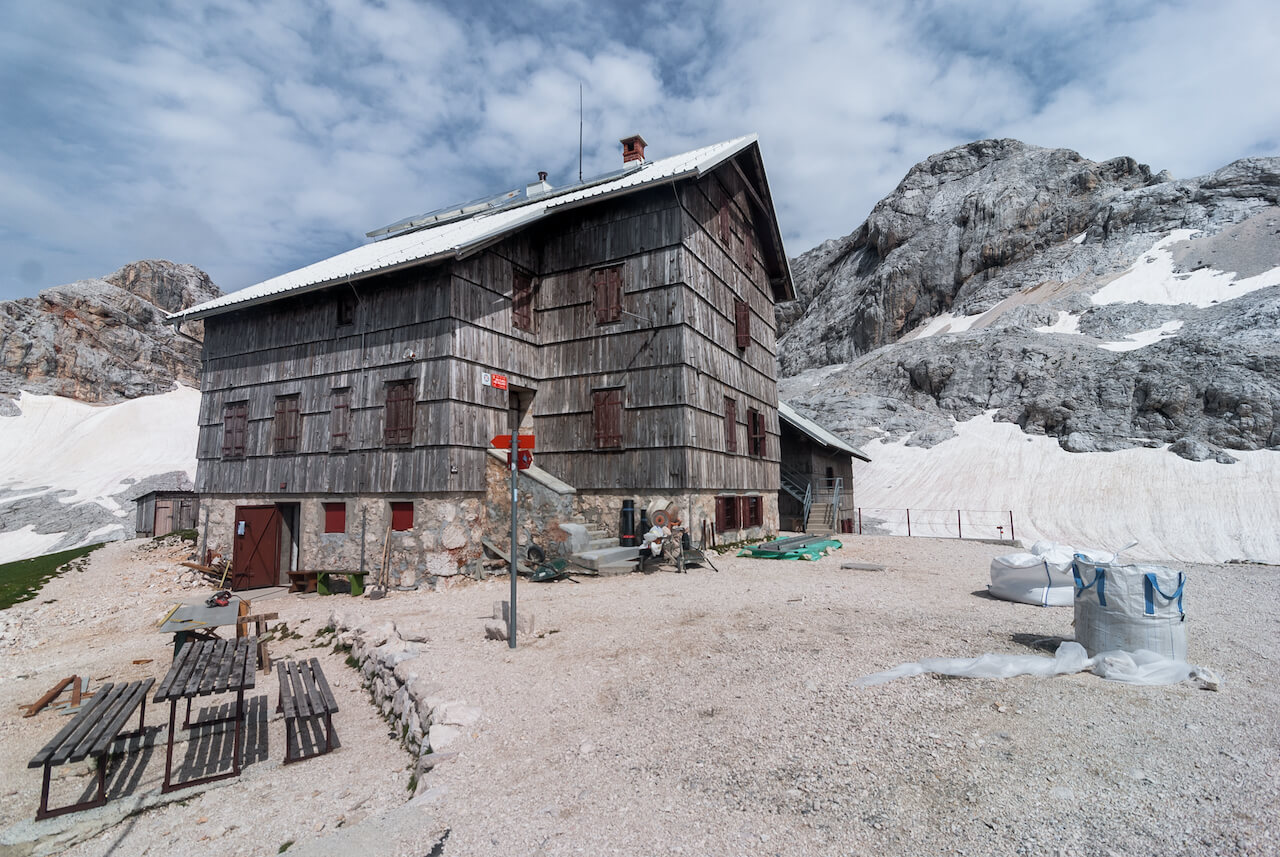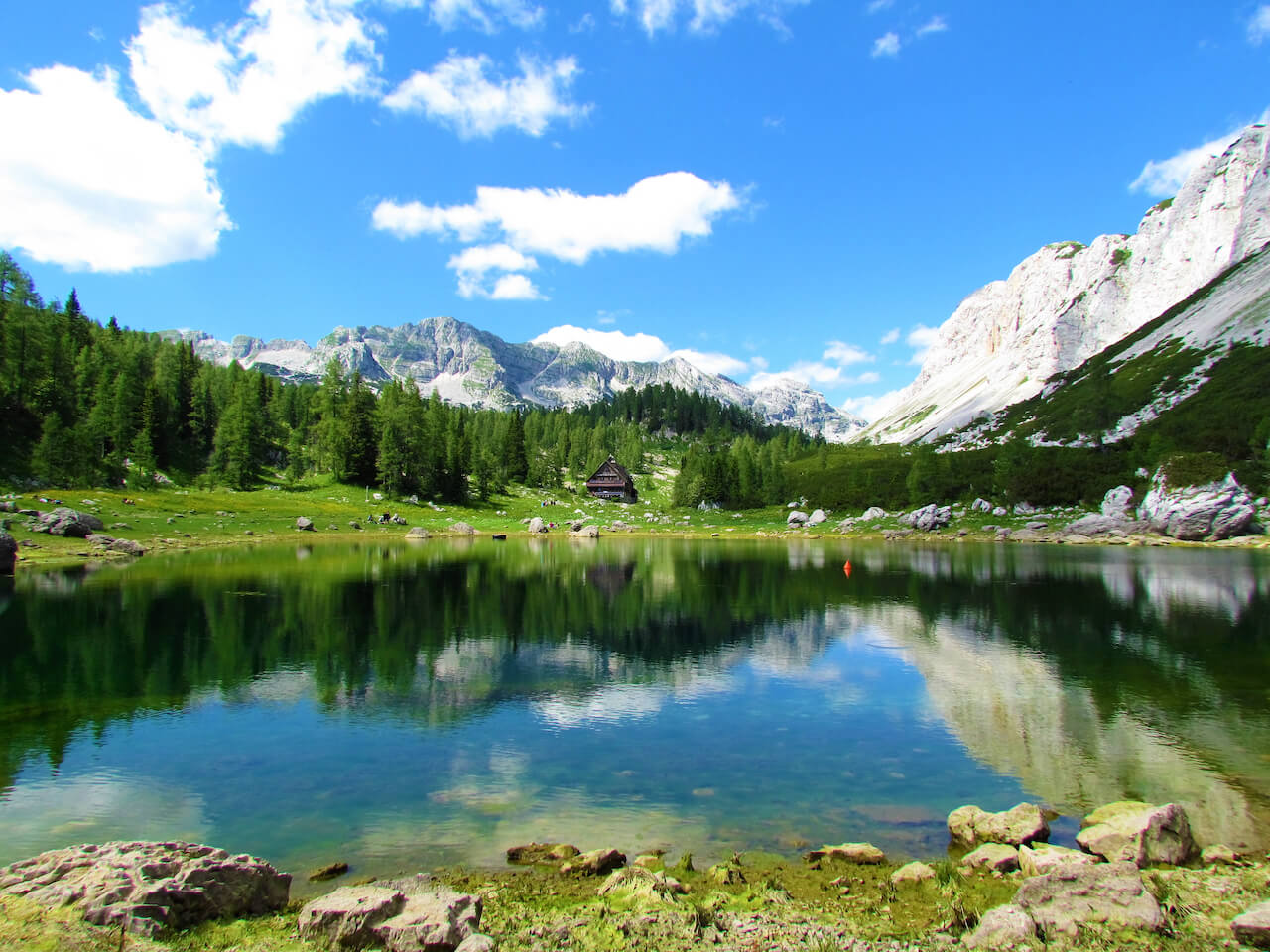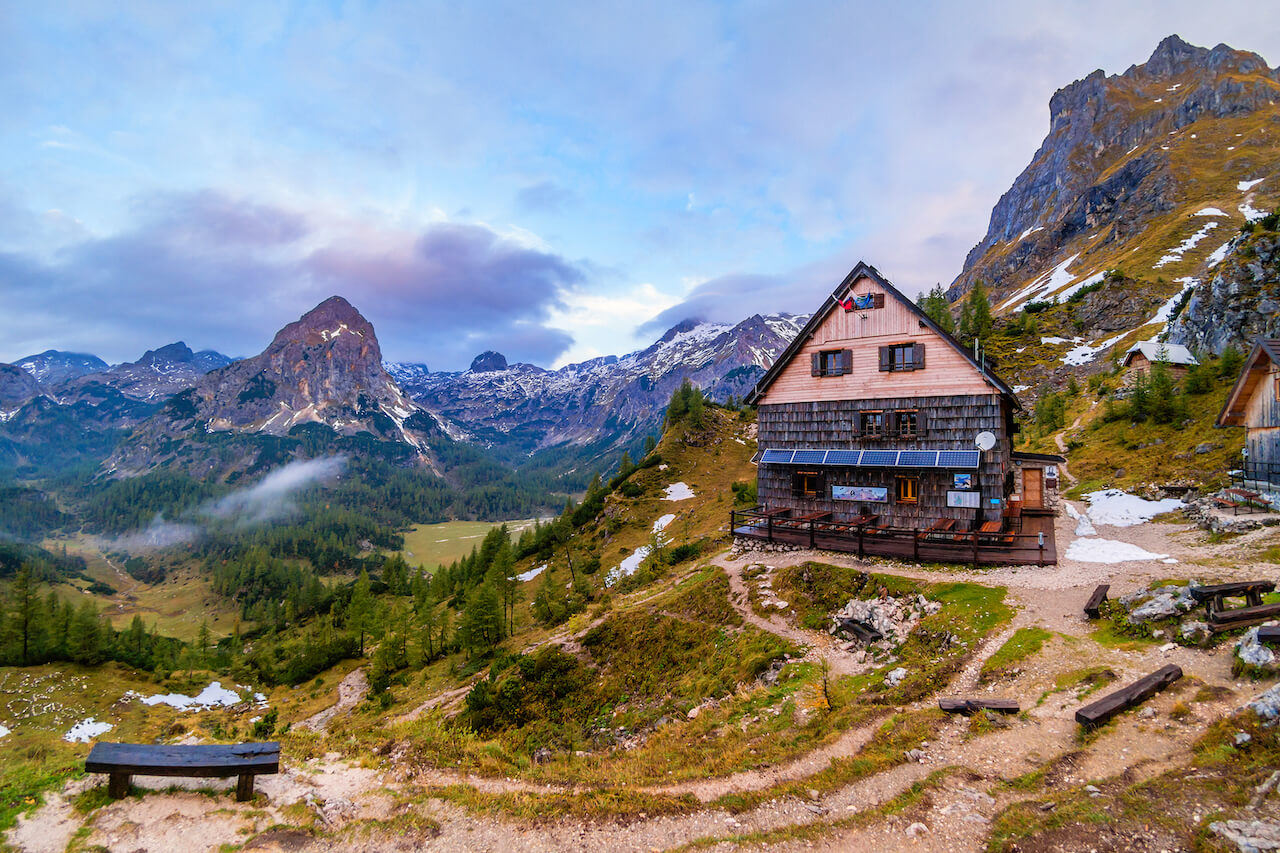Ljubljana related
Slovenia is a nation of mountaineers and hikers. The first hut was built in 1893. Now, over 160 mountain huts are standing, managed by the local hiking clubs under the Alpine Association of Slovenia. Each area of the Julian Alps, the Kamnik-Savinja Alps, and the Karawanke has at least one hut, some even more. They are there to provide shelter and a resting point for adventurous hikers on their hut-to-hut tour or brave mountaineers on their quest for greatness.
Even though huts are all over Slovenia, they share some commonalities. They are not a luxurious way to spend a night in the mountains, but an authentic place that brings you closer to the Slovenian mountain spirit. The food you can eat there is a part of that. The menu in mountain huts always consists of traditional homemade dishes that make a hiker's belly happy and the hiker ready for the next day of adventure.
An authentic experience in the mountains
The comfort found in these lodges is basic, but that doesn’t mean it’s not cosy. Most huts in the high-altitude don’t have drinking water because of the soluble rock surrounding them. Water and other supplies get transported to them by helicopter. Showers are therefore also a luxury, found only somewhere at lower altitudes.
Apart from all the stuff you need to take with you on every hike, you need to take some extra when staying in huts. That means extra clothes, some cash if they don’t have a reliable internet signal, your ID and the UIAA membership card if you want a discount. They have both dormitories and private rooms available for booking, but I recommend you do it early since the huts are quite crowded in the summer.
Staying in mountain huts is a wonderful thing that every hiker must experience. It is not only extra time spent in the mountains — It’s a place to meet like-minded people with whom you can connect. And don’t forget, you will be able to watch both the sunset and the sunrise. The sun coming down or up and colouring the peaks in exceptionally magnificent colours will be a sight you will never forget. I couldn’t recommend you more to see it at least once. And staying the night in a mountain hut requires the least amount of effort.
Some of the best mountain huts in Slovenia
When someone thinks of the huts in Slovenia, the huts under Triglav probably come to mind first. Planika Lodge at Triglav is our favourite. It is the most convenient option if you want to include Triglav in your hut-to-hut tour and is a smaller, more authentic alternative to the better known Kredarica hut. Its name comes from the Slovenian name for the Edelweiss flower. It stands on the edge of the southern plateau beneath Triglav, with an excellent view that stretches far down south to the Adriatic sea.

Plankia Lodge
The next must-visit hut is located in one of the most picturesque areas of the Triglav National Park, the Triglav Lakes Valley. Standing next to the Double Lake, the Triglav Lakes Lodge is the perfect resting place on your Seven Lakes Valley Hut to Hut Hike. Surrounded by a rocky ridge on one side and the forest that turns yellow in autumn on the other, it is a magnificent place to spend a night.

Related: Climbing Mount Triglav with Slovenia Discovery
Last but not least, it is the Vodnik Lodge on Velo Polje. It stands on the crossroads of many different routes in the heart of the Julian Alps, which makes it a convenient option for many hut-to-hut hikers. If you’re coming from Pokljuka plateau, Lake Bohinj or the Krma Valley and are heading to Triglav or the Seven Lakes Valley, be sure to stop here. The night will be one of the more comfortable ones on your tour, maybe even your last day with a proper shower.

Besides these three, there are more equally awesome but unique huts in the Slovenian mountains. Be sure to check them out and add them to your plan for the perfect hut-to-hut tour in Slovenia.
STA, 22 January 2022 - An Austrian skier who went missing on Friday while skiing off piste in the area of Mt Stol in the Karawanken mountain range in northern Slovenia was found dead on Saturday morning, the Slovenian Administration for Civil Protection and Disaster Relief says on its website.
The skier was found some 200 metres below the Stol ridge, in which he apparently fell in his ski boots, and died on the spot, the Kranj Police Department said.
The rescuers from Radovljica mounted a rescue operation on Stol's southern face yesterday and resumed it this morning. The rescue operation was also carried out on the Austrian sides of the border.
STA, 16 January 2022 - In two unrelated accidents, two mountaineers died on Sunday while climbing the Mali Triglav mountain in the Julian Alps, the third highest peak in Slovenia. In both cases, all the circumstances point to an accident in very difficult conditions, the Kranj Police Department said.
The first fatal accident occurred around 10am when a Slovenian citizen fell to his death, followed by the second, which involved a foreigner who met the same fate on the same spot only an hour later.
The rescue teams featured a helicopter crew of the Slovenian Armed Forces, mountain rescuers from Mojstrana and the Mountain Police Unit.
Conditions in the mountains are currently very difficult, with snow and ice covering the trails, so the Kranj police are again urging people to exercise great caution when visiting the mountains.
These were not the first tragic mountaineering accidents in Slovenia this weekend, as on Saturday, a 37-year-old Croatian mountaineer died in the Kamnik Saddle area in the Kamnik-Savinja Alps.
STA, 15 January 2021 - A climber from Croatia died in a mountaineering accident in the Slovenian Alps on Saturday. The 37-year-old was with a group of eight other climbers from Croatia when he slipped on a steep slope, plunging more than 300 metres.
The accident occurred around midday around Kamniško Sedlo, a saddle in the Kamnik-Savinja Alps between Mount Brana and Mount Planjava, the Civil Protection and Disaster Relief Administration said.
Mountain rescuers were dispatched to the scene and the man's body was airlifted to the valley. The remaining members of the group were not injured.
STA, 4 November 2021 - A pair of Slovenian mountaineers have succeeded in making the first ascent on a new 1700m route on the north-west face of Mount Chobutse (6680 m) in Nepal, which they named Slovenian Direct, the Slovenian Mountaineering Association has reported.
The top Slovenian climbing team of Luka Stražar and Nejc Marčič, along with Marko Prezelj and Matija Volontar, succeeded in making a first ascent on a new route on mount Chobutse (sometimes spelled Chobuje or Tsoboje) in Nepal between 28 and 30 October, reports the ExplorersWeb portal.
The climbers split into two roped teams: Stražar and Marčič successfully went for the west face, while Prezelj and Volontar gave the south face a try, but with less luck - strong winds eventually forced them back.
The route is a combination of technical difficulty and high altitude climbing, while the wind and cold made the experience truly Himalayan, wrote the Slovenian Mountaineering Association (PZS).
"The 1700-metre route is characterised by challenging and exposed climbing in the central part, while the ascent was marked by low temperatures and strong winds with avalanches. The climbers descended down the west side and reached base camp just before departure," the PZS added.
Stražar and Marčič rated the new Slovenian Direct route ED (Extremely hard - the second-highest level of the French scale), M5 (mixed climbing difficulty) and AI5 (Alpine Ice).
Four previous expeditions had climbed Mount Chobutse in the remote Himalayan region of Rolwaling in Nepal, with the first one being a German expedition in 1972, while Slovenian mountaineers now made the first ascent via the north-west face.
Stražar, Marčič and Prezelj are among the most renowned high-altitude alpine-style experts nowadays, writes the ExplorersWeb portal. They hold a total of seven Piolets d'Or among them.
Stražar and Marčič received one in 2012 for climbing the north-east face of K7 West (6615 m) in Pakistan in 2011, while Stražar received another in 2019 together with Aleš Česen and Tom Livingstone for a first ascent on the north face of Latok 1.
The Rolwaling 2021 expedition, also co-financed by the PZS, is expected to return to Slovenia at the end of the week.
See more photos at the PZS website
STA, 25 August 2020 - Slovenian mountain runner Luka Kovačič has accomplished a new feat by climbing the five highest mountains in Slovenia in less than 14 hours, by his own account.
The three-time winner of the race up the Planica ski flying hill managed to climb Visoki Rokav (2,646m), Škrlatica (2,740m), Triglav (2,864m), Jalovec (2,645m) and Mangart (2,679m) in north-western Slovenia.
Kovačič initially thought he would need a whole 24 hours for the feat, so he even surprised himself by climbing the five mountains in one go in 13 hours and 56 minutes.
A part of the run on Škrlatica took place on a very rocky terrain, which required alpine climbing abilities.
"I have been dreaming for a long time about connecting these mountains in one day. I wondered if it is possible in 24 hours and now I managed it in less than 14 hours," he said.
Kovačič climbed 6,600 metres overall, and covered 55 kilometres, of which 43 kilometres was mountain paths and rocks, seven kilometres was macadam and five kilometres paved road.
This was the day when I wasn't competing, I was just transforming my dreams into reality. It was a long day, but I...
Posted by Luka Kovačič on Tuesday, 25 August 2020
The first three hours he ran in complete darkness, while during individual stages he was accompanied by colleague who provided him with morale. His girlfriend Urška Ahac also provided support during one stage.
"Perhaps the toughest part was the climb to Jalovec, in the middle of the day, when it became really hot and there was no wind at all. But I beat the crisis and everything went better than expected thereafter.
"I can tell with full honesty that I enjoyed the entire 14 hours," added the extreme athlete who trains more than 900 hours a year.
"A project such as this requires a complete person, who can stay focused for the entire 14 hours despite the physical intensity. This is not possible without an exceptional physical fitness," he concluded.
The tourist vouchers every permanent resident of Slovenia will receive to be spent on accommodation (with our without breakfast) from June 19, 2020 on can also be used for accommodation in mountain huts.
"In the Alpine Association of Slovenia we are happy that parts of vouchers can be spent in mountain huts as well, and we therefore wish for as many Slovenians as possible to spend their holidays in the embrace of the mountains this year. We are pleased that the decision-makers recognized our arguments and found solutions for us in the preparation of the regulation. I would especially like to thank the Slovenian government, the Ministry of Economic Development and Technology, the Directorate for Tourism and MP Mateja Udovč," said Secretary General of the Alpine Association of Slovenia, Matej Planko.
A word of warning though, if you’d like to go to the mountains with your voucher. Although the internet connections in huts are mostly reliable, if there’s any lost connectivity with the FURS website, required for your voucher to be cashed in, then you’ll have to pay for the accommodation out of your own pocket, then the service provider will send a certificate to FURS who will then return the money paid and deduct it from your voucher.
STA, 11 May 2022 - Tone Škarja, a professional climber considered one of the pillars of Slovenian mountaineering, has died. The 83-year-old, famous for numerous challenging expeditions, was also a mountain guide, author and photographer.
His death was confirmed on Monday by Matjaž Šerkezi of the Slovenian Alpine Association (PZS).
Škarja, who had been a member of the organisation since 1951, started pursuing mountaineering professionally in 1956. He completed more than 1,000 alpine ascents, including participating in more than 30 trailblazing expeditions.
The 83-year-old was also part of the Yugoslavian Mount Everest expedition in 1979. The mostly Slovenian team scaled the world's highest peak by climbing the western ridge, still unexplored by then.
Later that year, Škarja received the Bloudek Award, Slovenia's most prestigious sports accolade, for the achievement. Together with another legendary climber, Aleš Kunaver, who passed away in the 1980s, he led the successful expedition, the PZS organisation said.
Škarja was also the head of the Kamnik mountain rescue team as well as the chairman of the PZS commission of foreign expeditions. Moreover, he was vice-president of the association between 1998 and 2011.
The Slovenian segment of the Nepal International Mountain Museum was set up and managed by Škarja.
Viki Grošelj, a climber who has scaled the most eight-thousanders among the Slovenian mountaineering elite and the first Slovenian to have climbed the highest summits of all the continents, has responded to today's sad news by highlighting the important role Škarja played in promoting Slovenia's mountaineering and raising it to the highest level.
"I was deeply hurt and shaken by the news of his death, but not completely unprepared since Škarja had been ill for quite some time," Grošelj said, adding that the departed was a mentor and a role model to numerous generations of climbers.
All our stories on mountaineering in Slovenia are here
If you’re a regular reader of TSN, or visitor to Slovenia, you’re no doubt aware of this country’s outsized reputation and achievements with regard to alpinism, a story told in the wonderful Alpine Warriors, which follows the two or three generations of Slovenian climbers who came to prominence in the 1960s to 1990s. These athletes were key players in the dramatic changes overtaking the sport of alpinism as it evolved from a nationalist, state-sponsored activity to a more individual and commercialised one, with documentaries, energy bars and branded jackets, not to mention the opening of Everest to weekend climbers and those in mid-life crises. The same years saw a move from huge, months-long siege-style expedition climbs with dozens of high altitude porters and tons of equipment, to the light and fast style that at its most extreme ends up in solo ascents with only what you can carry in a backpack, up and down mountain in a few days. The idea being that the faster you move, the less danger you’re exposed to in terms of the elements.
One of the names in that book, a controversial one, is Tomo Česen, the father of Aleš Česen, who in August 2018 was part of a Slovenian-British expedition that also featured Luka Stražar and Tom Livingston. The trio became the first to conquer the north face of Latok I (7,145 meters), part of the central Karakoram mountain range in Pakistan, and at the time widely viewed as the most coveted prize in high-altitude climbing. It was a feat that won them the 2019 Piolet d'Or, the top award in mountaineering.
Luckily for armchair adventurers, their ascent was captured on video, with the footage shot by the three climbers, along with Urška Pribošič and Jure Niedorfer, with the latter pair also responsible for editing and post-production work. Even luckier, the whole thing is on Vimeo, and you can see it below.
LATOK 1 from Jure Niedorfer on Vimeo.
The 14th Mountain Film Festival is in Slovenia this week, with screenings, talks and more in Cankarjev dom Ljubljana, Metropol Celje, Mestni kino Domžale, Kino Radol’ca and Kino Slovensko Bistrica.
The festival has an excellent English website, with details of all the events, but be aware there’ll be lectures from the likes of David Debeljak, Jera Musič – the first Slovenian woman to hike the 3,500-km long Appalachian Trail, Jim Donini, Milan Romih and Tomaž Jakofčič, and the chance to buy books, hang out and talk about climbing and hiking, with appearances by many giants of the local scene.
Related: Alpine Warriors, A History of Modern Slovenian Alpinism
With regard to films there’s documentaries, long and short, with programmes that offer great variety while giving the rare opportunity to see these films on the big screen, where the power of the landscapes they celebrate is more readily perceived. Take a look at some (not all) of the trailers below, and see more details here.
CHOLITAS_trailer EN from Arena Comunicación Audiovisual on Vimeo.
Drømmeland - Trailer from Square Eyes on Vimeo.




